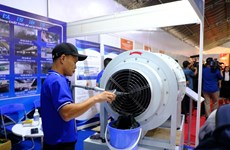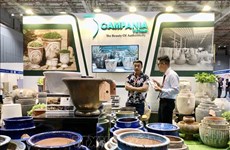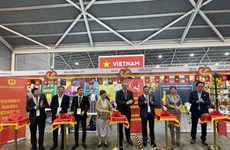Leather producers offered assistance for environmental problem solving
The Ministry of Industry and Trade (MOIT) has vowed to tackle domestic
leather businesses' difficulties in expanding their businesses, the
Vietnam Economic News reported on March 13.
The Ministry of Industry and Trade (MOIT) has vowed to tackle domestic
leather businesses' difficulties in expanding their businesses, the
Vietnam Economic News reported on March 13.
Building exclusive industrial zones with waste treatment facilities for leather businesses is one of the solutions to implement the master plan for Vietnamese leather and footwear sector development towards 2020 with a vision to 2025, which has been approved by the MOIT. So far, however, the solution has not been taken due to a lack of capital and environmental factors.
Former Deputy Minister of Industry and Trade Do Huu Hao said that leather production facilities create solid, liquid waste and exhaust fumes, the treatment of which requires specific technologies, therefore almost no province wanted to encourage investment in leather production.
Although leather production has grown in recent years, leather businesses still face numerous difficulties in expanding production due to the lack of exclusive industrial zones. Leather businesses still fail to cooperate with each other in dealing with environmental problems. Building its own wastewater treatment facility is beyond the financial capacity of a single leather business.
Bui Van Duc, Chairman of the Board at the Sagoda Leather Footwear Joint Stock Company, said: “We are seeking possibilities of investing in a leather factory. We have surveyed many localities but none of them supported our project, so we have not found a place to build the factory.”
Environmental problems have hindered the development of leather businesses. Specific environmental standards which can be applied to leather businesses are still lacking. Meanwhile, data from the Vietnam Leather, Footwear and Handbag Association (LEFASO) show that the whole country currently has 35 leather businesses, 62 percent of which are small-to-medium sized private companies which are financially incapable of investing in adequate waste treatment systems.
According to LEFASO Secretary General Phan Thi Thanh Xuan, leather businesses currently are capable to produce 350 million square feet (sqft) each year, meeting 40 percent of the amount required to make leather products for export.
It is expected that footwear businesses will need 700-750 million sqft of leather by 2015 and the demand will continue to increase in the ensuing years. Therefore, if domestic leather businesses do not invest in expanding production, they will be able to meet a lower percentage of the actual demand.
Developing the leather industry is necessary to increase the export value of Vietnamese footwear. Trade agreements, especially the Trans-Pacific Partnership Agreement (TPP), require export goods to meet specific requirements in terms of origin. So, Vietnamese leather and footwear businesses will be unable to make the most of advantages from these agreements if they fail to produce input materials required for production.
Aware of the important role of the leather industry to the development of businesses which make footwear and handbags for exports, the MOIT has taken the initiative in seeking solutions to boost domestic leather production. At a recent meeting held to discuss measures to develop the domestic leather industry, Deputy Minister of Industry and Trade Ho Thi Kim Thoa said that the MOIT would accompany leather businesses through difficulties and create favorable conditions for them to expand production.
Deputy Minister Ho Thi Kim Thoa required the Light Industry Department and LEFASO to accelerate the formation of exclusive industrial zones for leather businesses. She said that leather businesses should concentrate on creating products of high value.
She requested the Ministry of Natural Resources and Environment and the Ministry of Science and Technology to propose suitable environmental standards which can be applied to leather businesses and deal with problems currently facing them.
Exclusive industrial zones for leather businesses remain a desire which has not come true. The MOIT’s determination to untie these knots aims to promote the sustainable development of the entire leather and footwear sector.-VNA
Building exclusive industrial zones with waste treatment facilities for leather businesses is one of the solutions to implement the master plan for Vietnamese leather and footwear sector development towards 2020 with a vision to 2025, which has been approved by the MOIT. So far, however, the solution has not been taken due to a lack of capital and environmental factors.
Former Deputy Minister of Industry and Trade Do Huu Hao said that leather production facilities create solid, liquid waste and exhaust fumes, the treatment of which requires specific technologies, therefore almost no province wanted to encourage investment in leather production.
Although leather production has grown in recent years, leather businesses still face numerous difficulties in expanding production due to the lack of exclusive industrial zones. Leather businesses still fail to cooperate with each other in dealing with environmental problems. Building its own wastewater treatment facility is beyond the financial capacity of a single leather business.
Bui Van Duc, Chairman of the Board at the Sagoda Leather Footwear Joint Stock Company, said: “We are seeking possibilities of investing in a leather factory. We have surveyed many localities but none of them supported our project, so we have not found a place to build the factory.”
Environmental problems have hindered the development of leather businesses. Specific environmental standards which can be applied to leather businesses are still lacking. Meanwhile, data from the Vietnam Leather, Footwear and Handbag Association (LEFASO) show that the whole country currently has 35 leather businesses, 62 percent of which are small-to-medium sized private companies which are financially incapable of investing in adequate waste treatment systems.
According to LEFASO Secretary General Phan Thi Thanh Xuan, leather businesses currently are capable to produce 350 million square feet (sqft) each year, meeting 40 percent of the amount required to make leather products for export.
It is expected that footwear businesses will need 700-750 million sqft of leather by 2015 and the demand will continue to increase in the ensuing years. Therefore, if domestic leather businesses do not invest in expanding production, they will be able to meet a lower percentage of the actual demand.
Developing the leather industry is necessary to increase the export value of Vietnamese footwear. Trade agreements, especially the Trans-Pacific Partnership Agreement (TPP), require export goods to meet specific requirements in terms of origin. So, Vietnamese leather and footwear businesses will be unable to make the most of advantages from these agreements if they fail to produce input materials required for production.
Aware of the important role of the leather industry to the development of businesses which make footwear and handbags for exports, the MOIT has taken the initiative in seeking solutions to boost domestic leather production. At a recent meeting held to discuss measures to develop the domestic leather industry, Deputy Minister of Industry and Trade Ho Thi Kim Thoa said that the MOIT would accompany leather businesses through difficulties and create favorable conditions for them to expand production.
Deputy Minister Ho Thi Kim Thoa required the Light Industry Department and LEFASO to accelerate the formation of exclusive industrial zones for leather businesses. She said that leather businesses should concentrate on creating products of high value.
She requested the Ministry of Natural Resources and Environment and the Ministry of Science and Technology to propose suitable environmental standards which can be applied to leather businesses and deal with problems currently facing them.
Exclusive industrial zones for leather businesses remain a desire which has not come true. The MOIT’s determination to untie these knots aims to promote the sustainable development of the entire leather and footwear sector.-VNA













